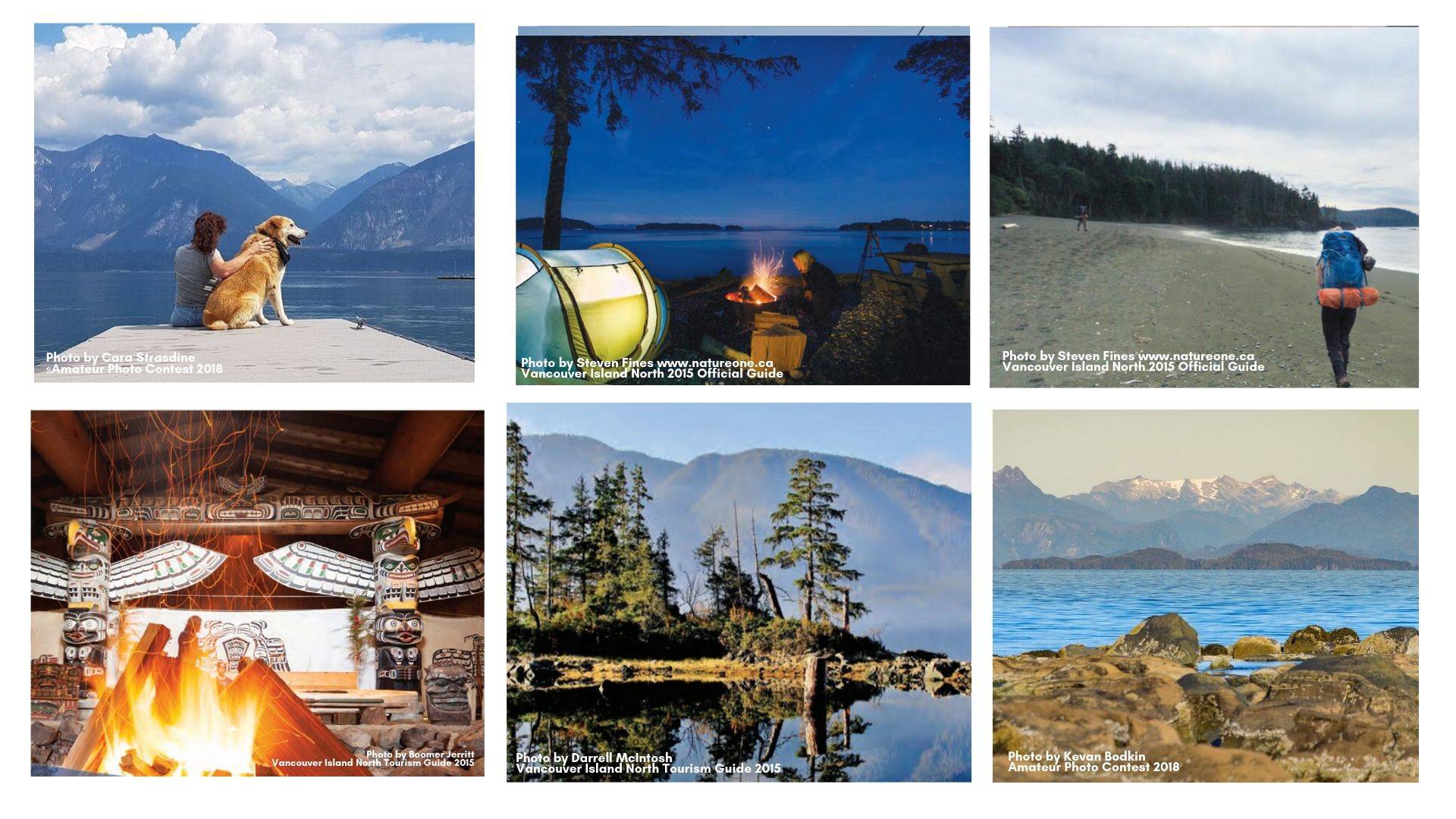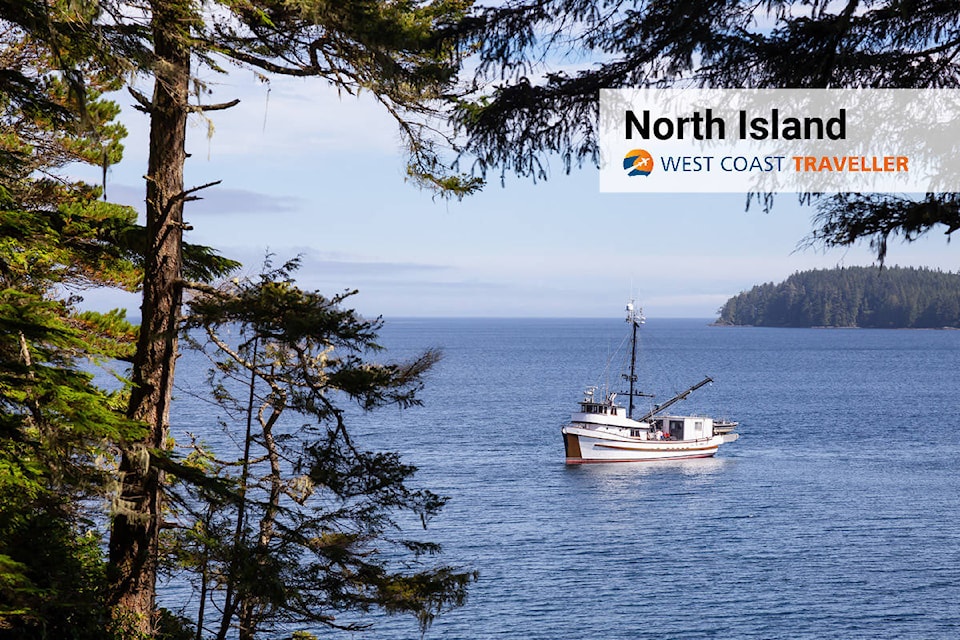The North Island region features a collection of communities on northern Vancouver Island, including Port Hardy, a bustling town of about 5,000, Port McNeill, a little farther south, Port Alice, Alert Bay, Sointula and Telegraph Cove.
Renowned for year-round adventures, Port Hardy is your base for a wide variety of outdoor pursuits, including guided hiking, kayaking and caving tours. Hike the North Coast Trail or take a leisurely stroll on Storey’s Beach.
Fishing is always popular and marine life, water clarity and tidal action also attract divers. Explore local wildlife by going bear, bird or whale watching.
In town, the Port Hardy Museum explores both European and First Nations history while the Quatse Salmon Stewardship Centre, open mid-May through September, is dedicated to salmon conservation and education.
In the area of Fort Rupert features First Nations artists at the Copper Maker Gallery. Holberg is known for beautiful Ronning Gardens and the Shoe Tree, a cedar snag covered in shoes, and is also the starting point for Cape Scott Park adventures. Winter Harbour is a tiny settlement with a boardwalk waterfront and great fishing charters.
Tucked into the forest and overlooking beautiful Broughton Strait, friendly Port McNeill is the hub of the North Island logging industry and an ideal base for outdoor adventures.
Get a feel for the region at the Port McNeill Museum or stroll the 1.5-hectare Shephard’s Garden. Fishing is superb here, as freshwater streams abound with trout and steelhead and offshore waters are famous for salmon, halibut, cod and snapper. Try a heli-fishing trip to the remote wilderness or a wildlife-watching excursion by land or by boat – another of Port McNeill’s most popular activities, along with kayaking, golfing, diving, caving, wind surfing, cultural tours and forestry tours.
BC Ferries connects Port McNeill with island communities of Alert Bay and Sointula.
Sointula, founded more than a century ago by Finnish settlers, has retained much of its Finnish flavour and the museum is the best place to explore Sointula’s past. Visit local art studios and galleries, or take in natural amenities including Lions Harbour, a popular boating stop. Choose from a variety of accommodations.
Alert Bay on Cormorant Island is rich with First Nations culture. Visit the renowned U’mista Cultural Centre, with its display of the repatriated Potlatch Collection and exhibits exploring the fascinating traditions of the Kwakwaka’wakw, and the Alert Bay Library-Museum, with a variety of artifacts and photographs.
The ‘Namgis Burial Grounds, easily viewed from the roadside as entry to the site is not permitted, is another must-see historic site, along with the world’s tallest totem pole. Stop by the Visitor Centre for a brochure highlighting the many totem poles around the Island. The traditional ‘Namgis Big House can be viewed from the outside only, unless you’re visiting during July and August when the T’sasała Cultural group dances on Thursdays, Fridays and Saturdays.
Founded in 1912 as a one-room telegraph station, Telegraph Cove is today an acclaimed fishing and adventure destination, calling kayakers, divers, fishers, boaters and bird, bear and whale-watchers.
Most of the community’s buildings are perched over the water on pilings. Wander the boardwalks to watch the fishing vessels, yachts and whale watching boats enter the cove. Rent a kayak for your own adventures or book a whale- or wildlife-watching excursion. On shore, be sure to visit the Whale Interpretive Centre, a marine mammal education centre open mid-May to October.
Several accommodation options are available, along with dining, supplies and various adventure packages.
Facts
- Known as the oldest known site of human habitation on Vancouver Island
- A dig at Beaver Cover uncovered evidence dating back to circa 5850 BCE
- The northernmost point of the Vancouver Island Highway Highway 19 and is marked by a monument of a wooden carrot in Carrot Park.
- Port Hardy offers the opportunity to take a floatplane to the Great Bear Rainforest where the world’s only white spirit bear lives
- World-famous for the best cold-water diving experiences.
Weather
Port Hardy’s proximity to the ocean gives it a mild and temperate climate with cool summers and common rainfall throughout the year.
Getting here
Ferry: BC Ferries offers services from the Vancouver area of Tsawwassen or Horseshoe Bay to Nanaimo at Duke Point. From Nanaimo take Highway 19 north to Port Hardy.
Vehicle: From Victoria take BC-19 N to Port Hardy this about a five and a half-hour drive. From Nanaimo take BC-19 N to Port Hardy which is nearly a four-hour drive.
Bus: Tofino bus operates between the Vancouver Island North region and the rest of Vancouver Island
Flying: The Port Hardy Airport is located 10 km east of Port Hardy’s downtown. Pacific Coastal Airlines also offers seaplanes from Vancouver to Port Hardy.
For more visit WestCoastTraveller or North Island Gazette

